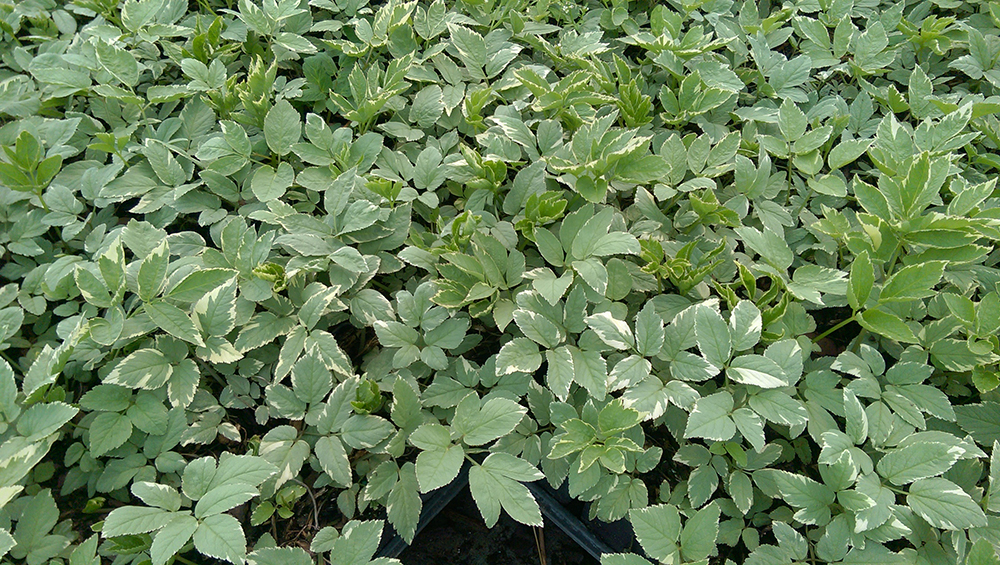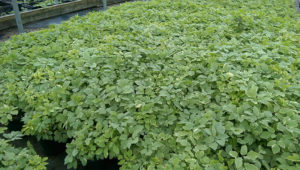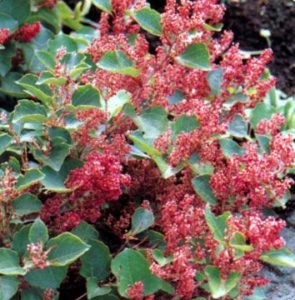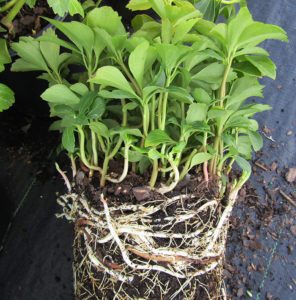
Many years ago I used to do actual work and one of the jobs consisted of writing up the descriptions for our plant availability listing, catalog, price list, or whatever the politically correct term is that we should use these days. I decided that if our customers were smart enough to be able to make enough money to pay for the plants they got from us, then they would be too smart to be impressed by such terms as “jaw-dropping” and so I might as well be honest and accurate in my descriptions which is why I described Aegopodium podagraria as being ‘invasive’. At that stage in my career I was cheerfully unaware of the legal implications to this term. We used to just grow plants on the theory that whoever wanted to buy them would have to live with their conscience. I salved my conscience by stating, in my periodic nursery newsletters, that because I had two kids in college at that time I got a pass for growing aegepodium.

Anyhow, when the catalog came out I got a call from Dave MacKenzie, famously of Hortech Nursery somewhere north of us here in Michigan. Dave, knowing something about botany and being civic minded, had just spent a lot of time in Lansing (the capital of this fine state) dealing with the legislature and with nursery lobbyists in an attempt to achieve something resembling common sense. The do-gooders up in the legislature wanted to label every possible plant as being invasive so they could ban the growing and sale of the plant in the state. Of course, all of the standard invasive plants inflicted upon us from foreign soils had long since spread all over the place such that nothing the nursery business could do could possibly make it worse. Lythrum salicaria had been banned after half the state of Minnesota was covered with it. Analogies to closing the barn door after the horses have left came to mind, along with the thought that few people would understand the reference to barns and horses. These days state legislatures are all over banning the propagation and sale of Phragmites australis. Not that it ever was or ever will be a nursery plant to be sold at garden centers, or even by the mail order people. Phragmites has spread all across America because of the Interstate highway system, incidentally.

And then there is Fallopia japonica that used to be called Reynoutria and then Polygonum and that the newspapers all call ‘Japanese Knotweed’ and describe it as being terrible. Here, again, no one is growing this plant in a nursery and selling it as an ornamental, so we wonder at the functionality of banning it. There is some on one of my farms because it had been planted around the old farm house and it does not take over the world. It just sits there. As I understand it this is one of the best bee foods ever. It blooms with big white flowers in late summer. Actually it is big plumes of little flowers so it is easy for the bees to reach the nectar or pollen or whatever bees eat, I keep forgetting to ask them. Nowadays, the latest fad is to eat this plant. The more exotic expensive restaurants use it proving the point that there are a lot of strange people out there.
So, Dave told me to never use the word invasive to describe a plant in my catalog because that was a technical legal term. I had thought it to be a regular normal term. And so if you look up Aegopodium on page 58 of Dave MacKenzie’s 1997 magnus opus, Perennial Ground Covers, you will find the following description. “The common names of this species cause one to wonder if the plant is a weed or a tree. In fact, it is a wonder if the plant is a weed or a tree. In fact, it is a very aggressive (potentially weedy) rhizomatous, herbaceous, 6- to 14-inch-tall, indefinite-spreading ground cover with foliage resembling that of an ash or elder tree. Well suited for covering moderate to large areas, provided that its stubbornly spreading rootstock can be kept in check, bishop’s weed is both durable and attractive.”
I guess that if a person is writing a 378 page book, then one will want to figure out how to use a hundred words when one—the old-fashioned word invasive—would do. The term ‘indefinite-spreading’ is a new one for me, but certainly useful for a ground cover grower. And this reminds me of Houttuynia cordata that Dave, page 187, likewise defines as: “spreads indefinitely”, and “tenacious rhizomatous habit” and “surrounded by a deep edging or sidewalk.” We still list this plant but it has been a couple of years since we stopped propagating it. As soon as we run out of it we will be out of that business. I threatened to sit down in the middle of the office and go on a hunger strike if we persisted in propagating houttuynia and the crew decided to go along. I think it was less out of concern for my health than it was because of an awareness that my personality degenerates substantially when I am hypoglycemic.
We found out last week that in the great state of Wisconsin Aegepodium has been outlawed as being invasive. We will not be shipping that plant to that state in the future if we can remember all of these things. I was more bemused than amused to learn of this banning business because years ago I drove cross-country all across Wisconsin once and in every little town there were well kept-up houses and mown lawns and no trash blowing around and a patch of aegepodium on each side of the front steps. Sometimes the patch extended the full length of the sidewalk out to the road. You would think that Wisconsin, of all places, with the tradition of neat Scandinavian immigrants, would allow the newer and younger inhabitants to continue with the old traditions. They let cows wander all over that state, doing you know what, and then discriminate against aegepodium.

This doing research is always good and so I continued on in Dave’s book to page 135 to read upon Duchesnea indica common names Mock Strawberry or Indian Strawberry. For years I had assumed (incorrectly so) that this was a native American plant when, in fact, it came from the Asian sub-continent, hence the name indica that means ‘of India’ even though it is a zone 4 plant. This is truly a terrible plant. It spreads by stolons, which are the above-ground horizontal stems that produce new plantlets at their tips. You will recall that aegepodium spreads by rhizomes, which are white stems that grow under the ground. Pachysandra and Liriope spicata spread also by the rhizome method. But I digress, the worst thing about Indian strawberry are the berries that birds love. These things are loaded with seeds and the birds do their job of spreading them all over the country. At one time the Chicago Botanical Garden was so infested with Duchesnea indica that the volunteer weeding people were treating it like it was the labelled groundcover in that area. Since then someone came along who knew the difference and managed, somehow, to solve the problem.
And so we have had an exciting time here in the nursery business, busily growing all of the good groundcover plants and then not growing them when we find out that they cover the ground too well. Good taste must be rearing its ugly head from time to time.
The best part of Dave’s groundcover book is in the introduction when he talks about perceptual functions and cognitive dissonance. Here is the offending paragraph from page 16. You usually have to pay money to get something this good:
“Psychologists define dissonance as the anxiety, confusion, or frustration that arises when there is a difference between our values or expectations and the reality that confronts us. People sometimes experience dissonance when confronted with a disharmonious landscape. For example, dissonance may be experienced when plants are not effectively linked to each other or when plants stand apart from the architectural elements of the landscape. Fortunately, in a number of ways, ground covers can help prevent such mental distress.”
And so now I am pleased to note that by being in the groundcover business I am helping to make the world a better place. If I could make money while being in this business it will be even better.
